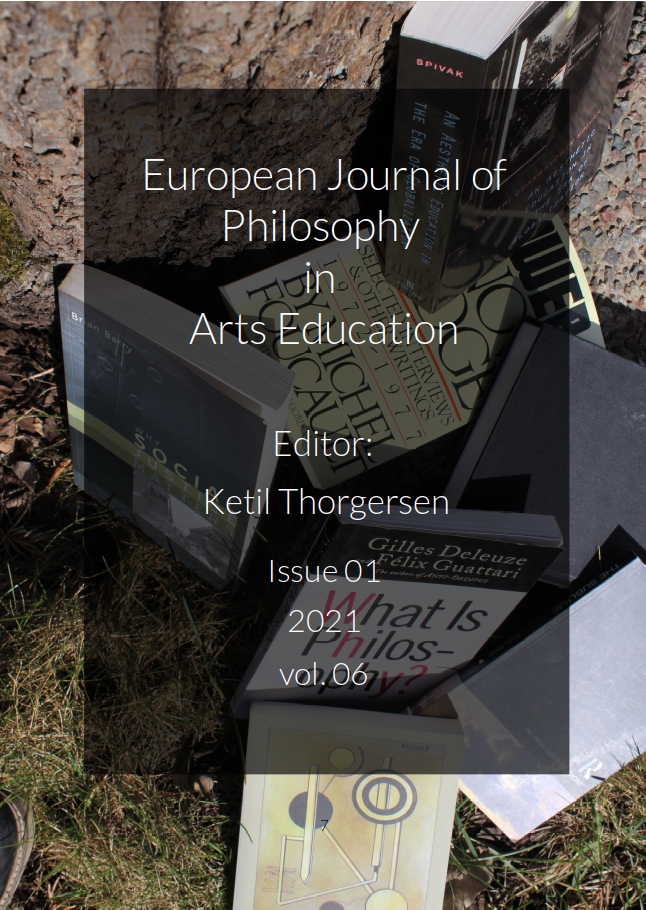Editorial Vol 06 2021 issue 1
Eighth issue of the European Journal of Philosophy in Arts Education
Abstract
EJPAE is proud to be able to present another issue with important thoughts in the intersection between the arts, education and philosophy. In this issue we have only been able to get two articles ready for publication. This is not because of lack of important and high quality articles submitted to EJPAE, but because of problems in the review and editorial processes. So while I am happy to present these two articles, I am also sad that I have not been able to get other articles ready for publication yet. To be an editor is a really interesting task where the meetings with interesting scholars and texts from different areas is the reward for the work you put in. In these trying times other work has had to be prioritised over the editorial work, and even if I have tried to get reviews to happen, several reviewers have obviously also had pressing times and I have experienced several reviewers withdrawing or even stop answering mail. This does not give me an excuse for all the articles waiting for a review, but at least it is one explanation – and for you I apologise and hope you will still be with us in the times to come.
That being said I present to you two interesting articles – both from Norway this time. The north part of Norway is perhaps more knows for snow and ice than for philosophy and art, but that is about to change with this issue of EJPAE. The first article is by Ola Buan Øien who has explored how concepts developed by Daniel Lanois can be useful in performances through arts based research. The concept investigated are sonic ambience, master station, operating by limitation, locations, preparing and black dubs. In this exploration he has turned inwards and analysed his own compositional process. Theoretically the study draws on the constructionist epistemological roots of Crotty combined with Gadamer’s more hermeneutic theories. The article gives sonic and visual examples of the process and takes the reader on a journey to show how these concepts operate in an actual creative process, while we simultaneously take part in Øien’s reflections on the process. The usefulness for educational practices in applying such approaches as demonstrated in the article, is discussed towards the end of the article, while at the same time discussing the academisation of artistic practices. The article is a thought provoking and useful read for teachers, teacher educators and artistic researchers from different disciplines even if the terminology is most recognisable for those involved with music.
The second article discusses the relationship between art and science and is written by Thomas Dillern. By using Leonardo da Vinci as an example, he shows that art and science as human endeavours share some common traits. Da Vinci is what we today call a renaissance-man – someone who were active and accomplished in what we today consider separate disciplines such as art, architecture, science, medicine etc. In the essay Dillern questions the ideals of objectivity and claims that human creativity is needed as much in scientific processes as in the arts. The scientific process is then compared to artistic processes in order to show the similarities between them and how both activities generate human understanding. In this Dillern builds on several philosophers such as Heidegger, Gadamer, Dewey, Polanyi and Beavington, but also the old cult author Robert Pirzig and his seminal novel The Art of Motorcycle Maintenance. Extrospection and instrosepction are parts of the same precess and needed in making sense of the world, Dillern argues, and therefore artistic approaches to science and scientific approaches to artistic creation are needed in education.
I hope this issue will bring hours of interesting thinking and if you feel inspired to follow up on something written here, or if you are provoked to write a reply, EJPAE will be happy to be a platform for such professional discussions.
As I finish this text, spring is about to break free of the cold arms of winter and I wish all of you a warmer and closer time ahead than the last year of social distancing.
Ketil Thorgersen
Editor in Chief Stockholm April 1th 2021

Downloads
Published
Issue
Section
License
Copyright (c) 2021 admin admin

This work is licensed under a Creative Commons Attribution 4.0 International License.
EJPAE provides immediate open access to all its published content. Users do not need to register or pay to read content.
https://creativecommons.org/licenses/by/4.0/
Authors of content published in European Journal of Philosophy in Arts Education (EJPAE) retain the copyright to their works. Content is free to be used by anyone as long as you "[...] give appropriate credit, provide a link to the license, and indicate if changes were made. You may do so in any reasonable manner, but not in any way that suggests the licensor endorses you or your use." and "No additional restrictions — You may not apply legal terms or technological measures that legally restrict others from doing anything the license permits." (from the Creative Commons licence agreement)
EJPAE does not charge any author or publication fees.
Authors are encouraged to deposit the final published version of their article for self-archiving (author's personal website) and/or archiving in an institutional repository immediately upon publication.




